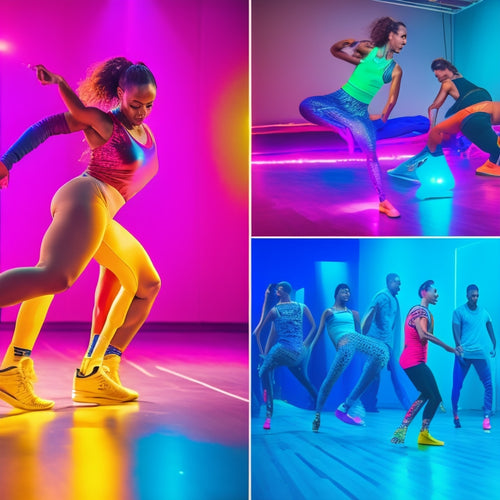
Why Flexible Hips Are Key to Pain-Free Dancing
Share
You depend on your hips to generate power, control, and fluid movement in dance, making flexible hips essential for pain-free dancing. By strengthening your hip flexors, glutes, and lower back muscles, you'll reduce the risk of injury and enhance your overall performance. Mastering pelvic tilt and control will give you efficient energy transfer and smooth movements. With consistent stretching and spatial awareness, you'll achieve flexibility and range of motion for pain-free dancing. Now, discover how to tap into your full potential and take your dancing to the next level.
Key Takeaways
• Flexible hips reduce the risk of injuries during dance routines by allowing for proper alignment and movement.
• Hip flexibility enhances lower body range of motion, enabling dancers to perform complex movements with ease.
• Proper hip alignment and flexibility improve overall posture, reducing strain on the lower back and knees.
• Flexible hips facilitate graceful and controlled movements, allowing dancers to execute choreography with precision and confidence.
• Hip flexibility minimizes the likelihood of chronic pain development, promoting a healthier and sustainable dance practice.
Building Strength Through Isolation
By targeting specific muscle groups, you can isolate and strengthen the hip flexors, glutes, and lower back muscles that are essential for pain-free dancing.
This isolation is vital, as it allows you to focus on the precise muscles that support your hips and prevent injuries.
Through muscle segmentation, you can identify and engage the specific muscles needed for best hip function.
For instance, your core stabilization is critical in maintaining good posture and alignment, which in turn reduces the risk of hip strain.
Unlocking Hip Flexibility Exercises
Now that you've developed strength in your hip flexors, glutes, and lower back muscles, it's time to focus on enhancing flexibility in your hips through a series of targeted exercises.
To improve hip flexibility, start by incorporating exercises that target the iliotibial (IT) band, a ligament that runs down the outside of your thigh. One effective exercise is the IT band stretch. Stand with your affected side closest to a wall, cross the opposite leg over the affected leg, and slowly lower your body toward the ground, keeping your back straight and engaging your core. Hold for 30 seconds and repeat on the other side.
Another exercise is the piriformis stretch. Sit on the floor with your affected leg crossed over your other leg, placing your hand on the knee of the crossed leg. Pull your knee toward your opposite shoulder, keeping your back straight and maintaining mindful breathing. Hold for 30 seconds and repeat on the other side.
Remember to breathe naturally and avoid bouncing, as this can cause injury.
Mastering Pelvic Tilt and Control
You'll find that mastering pelvic tilt and control is essential for achieving ideal hip flexibility and preventing injuries, as it allows you to maintain proper alignment and generate power efficiently. When you develop control over your pelvic tilt, you'll be able to move with more precision and fluidity, reducing the risk of strains and pulls.
To achieve this control, focus on engaging your core muscles to support your lower back and pelvis. This core engagement will help you maintain a neutral spine and pelvis, allowing you to move with more stability and power.
As you practice, focus on developing muscle memory by repeating exercises that target your pelvic tilt. Start with small movements, such as tilting your pelvis forward and backward, and gradually increase your range of motion as you build strength and control.
Remember to breathe naturally and avoid tensing up, as this can restrict your movement and cause discomfort. With consistent practice and patience, you'll develop the pelvic tilt and control necessary for pain-free dancing.
Dynamic Movement for Mobility
As you explore dynamic movement for mobility, you'll discover the importance of fluid joint rotation, efficient energy transfer, and proper body alignment. By focusing on these key elements, you'll be able to move with greater ease and precision, allowing you to dance with confidence and freedom.
Fluid Joint Rotation
By incorporating fluid joint rotation into your dance practice, you'll experience a significant increase in mobility, allowing for more efficient movement and reduced risk of injury. As you move, your joints will glide smoothly, reducing friction and promoting joint lubrication. This, additionally, will help maintain healthy joints and prevent unnecessary wear and tear.
With fluid joint rotation, you'll also generate rotational momentum, allowing you to move with greater ease and power. This momentum will help you shift seamlessly between movements, making your dancing look and feel more fluid and natural.
Furthermore, by maintaining controlled rotations, you'll reduce the stress on your joints and muscles, decreasing your risk of injury and allowing you to dance with confidence.
Efficient Energy Transfer
Efficient energy transfer is key to dynamic movement, enabling your body to harness and redirect force seamlessly, thereby enabling fluid mobility and explosive power in your dance movements. When you master efficient energy transfer, you'll be able to generate power without sacrificing control, allowing you to move with precision and confidence.
To achieve this, focus on core activation, which serves as the foundation for efficient energy transfer. Engage your core muscles to stabilize your body, allowing you to generate force from a solid base.
Next, work on muscle synchronization, ensuring that your muscles work together in harmony to produce smooth, coordinated movements. This synchronization enables your body to redirect force effectively, minimizing energy loss and maximizing power output.
Body Alignment Matters
You'll find that maintaining proper body alignment is essential for generating power and achieving fluid mobility in your dance movements, as it allows you to engage your core and redirect force effectively.
When you're aligned correctly, you'll experience improved posture awareness, which enables your body to move efficiently and safely. This, in turn, reduces the risk of injury and promotes pain-free dancing.
To maintain ideal body alignment, focus on the following key elements:
-
Engage your core: Activate your transverse abdominis muscle to support your lower back and pelvis.
-
Lengthen your spine: Maintain a neutral spine to allow for efficient energy transfer and fluid movement.
-
Align your shoulders: Keep your shoulders relaxed and down, avoiding scrunching or tension.
- Weight distribution: Evenly distribute your weight between both feet to maintain balance and stability.
Stretching Routines for Flexibility
Develop a consistent stretching routine to increase your flexibility, focusing on exercises that target your hip flexors, glutes, and lower back muscles. This will help you maintain proper alignment and reduce the risk of injury. Incorporate morning stretches into your daily routine to loosen up your muscles and prepare them for dance movements.
| Exercise | Target Muscle | Duration |
|---|---|---|
| Lying Leg Raises | Hip Flexors | 3 sets of 10 reps |
| Glute Bridges | Glutes | 3 sets of 15 reps |
| Knee to Chest Stretch | Lower Back | 30-second hold |
In addition to stretching, incorporate foam rolling into your routine to release tension in your muscles. Focus on rolling your IT band, quadriceps, and glutes to improve flexibility and reduce muscle soreness. Remember to hold each roll for 30 seconds to allow for maximum relaxation of the muscles. By incorporating these exercises into your daily routine, you'll be well on your way to achieving the flexibility and range of motion needed for pain-free dancing.
Flawless Transitions and Alignment
As you prepare to take your dancing to the next level, mastering seamless shifts and alignment becomes essential to executing intricate movements with precision and confidence. Flawless changes and alignment are critical components of pain-free dancing, as they allow you to move efficiently and safely.
To achieve this, focus on developing your Body Awareness. This means cultivating a deep understanding of your body's position in space, allowing you to make subtle adjustments and corrections as needed.
Here are some key elements to focus on:
-
Muscle Memory: Practice movements repeatedly to build muscle memory, enabling your body to execute complex sequences automatically.
-
Core Engagement: Engage your core muscles to maintain stability and control, ensuring smooth changes and precise alignment.
-
Weight Transfer: Master the art of weight transfer, shifting your weight seamlessly from one foot to the other while maintaining balance and poise.
- Spatial Awareness: Develop an acute sense of spatial awareness, allowing you to navigate the dance floor with ease and confidence.
Frequently Asked Questions
Can I Improve My Hip Flexibility if I'm Over 40 Years Old?
"Think you're too old to improve hip flexibility? Think again! While age limitations and hormonal changes can affect flexibility, you can still make significant gains with consistent practice and targeted exercises, even in your 40s and beyond."
How Often Should I Practice Hip Flexibility Exercises for Progress?
You should aim to practice hip flexibility exercises 2-3 times a week, ideally with 1-2 rest days in between, as Consistency matters and Patience is required to see progress - commit to a routine for noticeable results.
Do Flexible Hips Guarantee a Lifelong Dance Career Without Injuries?
While flexible hips greatly reduce injury risk, they don't guarantee a lifelong dance career without injuries; you'll still need to maintain proper technique, manage career expectations, and prioritize injury-proofing habits to secure a long, healthy dance career.
Can Hip Flexibility Exercises Also Improve My Posture and Balance?
As you incorporate hip flexibility exercises into your routine, you'll notice improved posture and balance, thanks to increased core engagement and proper pelvic alignment, allowing you to move with confidence and reduced risk of injury.
Are There Specific Hip Flexibility Exercises for Different Dance Styles?
'When you immerse yourself in dance-specific exercises, you'll find customized routines: for Ballet, concentrate on targeted mobilizations, while Contemporary flows involve fluid, dynamic stretches to enhance your expressive movements and guarantee safe, sustainable practices.'
Related Posts
-

Why Dance Makeup Artists Need Online Solutions
As a dance makeup artist, you're likely struggling to attract clients and grow your business due to poor online visib...
-

Best Adidas Dance Shoes for Unbeatable Moves
If you're looking for the best Adidas dance shoes to boost your performance, focus on models that offer superior grip...
-

Three Clicks Revolutionizes Online Marketplace Experience
Three Clicks is revolutionizing the online marketplace experience by seamlessly connecting buyers and sellers through...


